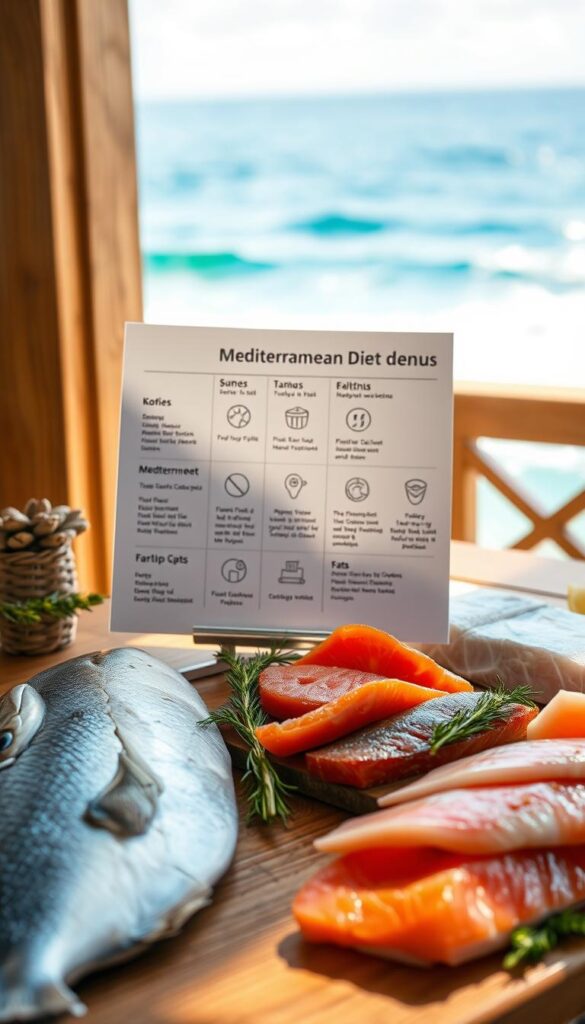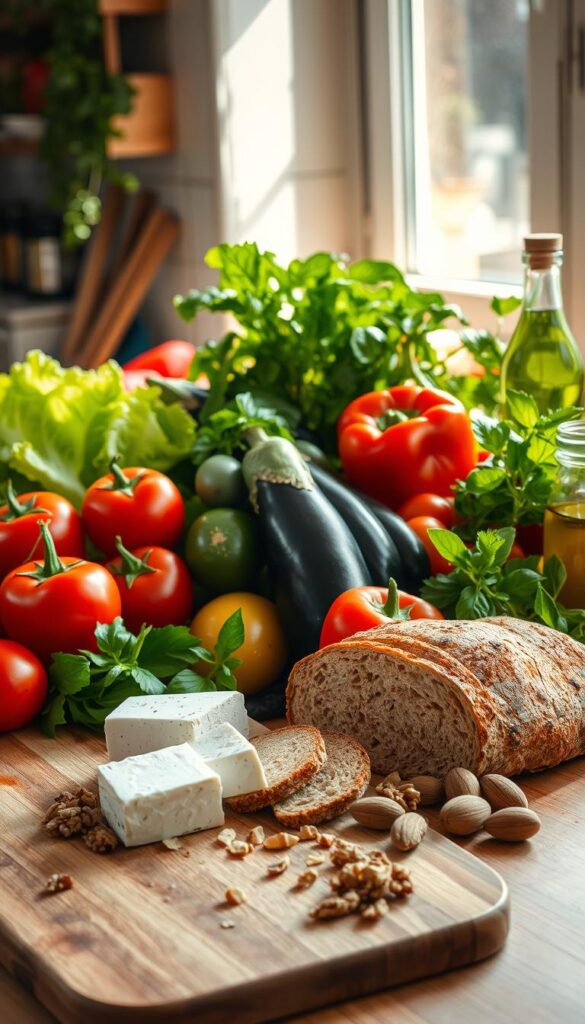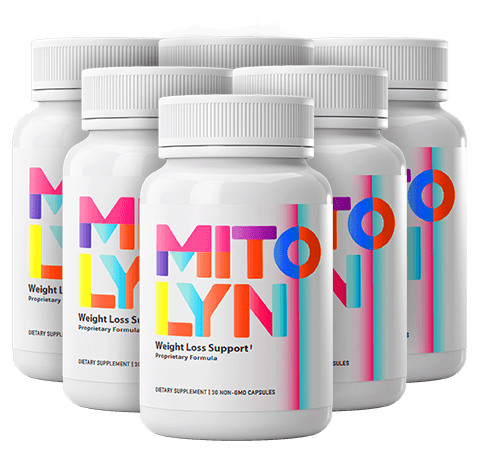
What if the secret to lasting health and weight loss isn’t strict rules? It’s a way of eating that’s been good for communities for thousands of years. The Mediterranean diet is the #1 diet, as ranked by U.S. News & World Report for eight years. It’s not just a trend; it’s science-backed.
It’s supported by the American Heart Association’s 2024 guidelines. This diet lowers stroke risk and boosts heart health. But how do its simple Mediterranean Diet Rules make meals a shield against disease?
Imagine a diet that pairs red wine with dinner and uses olive oil instead of butter. It still helps you lose weight. The Mediterranean Diet Principles focus on plant-based foods like leafy greens, nuts, and fish. It limits red meat and sugary snacks.
Studies show followers cut stroke risk by up to 30%. They also keep weight off long-term. Yet, many still wonder: how do these five core rules transform health so effectively?
Key Takeaways
- Ranked #1 diet for 8 years straight by U.S. News & World Report
- Cuts stroke risk by 30% per 2019 research
- Includes red wine in moderation as part of its guidelines
- Focuses on plant-based foods like nuts, olive oil, and fish
- Backed by American Heart Association recommendations
Understanding the Mediterranean Diet: An Ancient Approach to Modern Health
The Mediterranean diet is based on old traditions. It focuses on whole foods and balanced eating. It’s not just a trend, but a way of life for many.
The Historical Origins of Mediterranean Eating
Long before we knew about nutrition, people in Greece, Italy, and Spain ate local foods. Their diets were full of fresh veggies, olive oil, and seasonal foods. The Mediterranean Diet Guidelines were first noticed in the 1950s by Ancel Keys.
How the Mediterranean Diet Differs from Other Popular Diets
The Mediterranean diet is different from others. It’s not about cutting out foods. Instead, it balances Mediterranean Diet Benefits with flexibility. Here’s how it compares:
- It focuses on plant-based foods like veggies, fruits, and whole grains.
- It includes moderate amounts of fish, dairy, and poultry.
- It promotes healthy fats like olive oil over saturated fats.
It’s not as extreme as keto or as meat-focused as paleo. The Mediterranean diet is a balanced choice.
Why the Mediterranean Diet Has Stood the Test of Time
Science supports its long-lasting benefits. The Lyon Diet Heart Study showed it can cut heart events by 50% in five years. Its success comes from:
- Its tasty flavors and variety.
- It fits different tastes, like Italian pasta and Spanish seafood.
- It has proven health benefits, like lowering bad cholesterol and blood pressure.
By following these principles, you’re choosing a healthy lifestyle. It’s good for your body and honors your cultural roots.
The Fundamental Mediterranean Diet Rules You Need to Know
Starting the Mediterranean Diet Principles means making choices, not following strict rules. It’s about eating whole foods, enjoying flavors, and eating with others. The Mediterranean Diet Guidelines focus on plants like greens, veggies, and grains. These are backed by the Mayo Clinic.
“The Mediterranean diet is more than food—it’s a lifestyle that balances nourishment with enjoyment.” — Mayo Clinic
Here are the main points:
- Use olive oil for cooking and dressings.
- Eat fish like salmon or sardines twice a week for omega-3s.
- Have red meat only once a week. Choose beans or lentils for protein.
- Snack on raw nuts and fruit instead of junk food.
- Add herbs like oregano or garlic to meals for flavor without salt.

| Food Group | Weekly Target |
|---|---|
| Fresh vegetables | 6+ servings |
| Fatty fish | 2-3 servings |
| Whole grains | 3+ servings daily |
| Nuts | 4 small portions weekly |
It’s all about balance. Enjoy red wine in moderation (1 glass/day for women, 2 for men). Share meals with family and friends. This way, the diet fits your life, not the other way around.
Golden Rule #1: Embrace Plant-Based Foods as Your Foundation
Making plants the main part of your meals is key to Healthy Mediterranean Eating. The Mediterranean Diet Food List includes veggies, fruits, legumes, and whole grains. These foods give you fiber, vitamins, and antioxidants.
They boost your energy and lower the risk of heart disease and diabetes.

| Category | Examples |
|---|---|
| Vegetables | Spinach, kale, asparagus, sweet potatoes |
| Fruits | Berries, apples, oranges, melons |
| Legumes | Beans, lentils, chickpeas, peas |
| Whole Grains | Brown rice, quinoa, oats, buckwheat |
Vegetables: Your New Best Friends
Fill half your plate with colorful veggies every day. Steam spinach, roast Brussels sprouts, or toss arugula into salads. Pick seasonal veggies for the best taste and nutrition.
Fruits: Nature’s Desserts
Use fruits like peaches or grapes to satisfy your sweet tooth. Snack on berries for antioxidants or slice citrus for a refreshing treat. No need for processed sugars!
Legumes, Nuts and Seeds: Protein Powerhouses
Swap meat for lentils in soups or enjoy almonds as a snack. These foods offer protein and healthy fats without the saturated fats of animal products.
Whole Grains: Complex Carbohydrates That Satisfy
Choose brown rice over white bread. Whole grains keep you full longer and support gut health. Cook quinoa as a side or mix oats into smoothies.
Start small—add spinach to eggs or swap chips for apple slices. Every bite brings you closer to the Mediterranean Diet Food List and its lifelong benefits.
Golden Rule #2: Choose Healthy Fats, Especially Olive Oil
Healthy fats are key in the Mediterranean Diet Rules. Switch from butter and margarine to olive oil for your heart’s sake. Extra virgin olive oil is more than just for cooking; it’s packed with nutrients. Try to have 2 tablespoons a day, over salads, veggies, or popcorn for a tasty snack.
Studies show this change can lower bad cholesterol and fight inflammation.

- Olive oil: Use it for sautéing, dressings, and even baking. Choose cold-pressed, unfiltered for the best taste and health benefits.
- Avocados: Mash them into toast, blend into smoothies, or slice onto tacos for creaminess.
- Nuts & seeds: Snack on walnuts, pistachios, or sunflower seeds. Sprinkle them on yogurt or salads for a crunchy boost.
“Replacing saturated fats with olive oil can cut heart disease risk by 30%.” – Harvard School of Public Health
Follow Mediterranean Diet Tips by adding these fats to your meals. Swap mayo for avocado on sandwiches, or toss roasted veggies with olive oil and herbs. Even desserts like chocolate-dipped strawberries get a nutty twist. The idea is to make smart swaps that enhance taste and health.
Golden Rule #3: Moderate Your Protein Intake with a Focus on Fish
When following the Mediterranean Diet Guidelines, what you eat matters. Choose fish over red meat for omega-3s and to fight inflammation. Here’s how to balance your plate:

Why Fatty Fish Belong on Your Mediterranean Diet Food List
Fish like salmon, mackerel, and sardines are full of omega-3s. These fats help fight inflammation and keep your brain and heart healthy. Eating fish twice a week can help older adults keep their muscle strength up. Try grilled salmon or tuna salads to get more.
How Much Fish Should You Eat?
- Aim for 2–3 servings weekly of fatty fish
- Choose grilled, baked, or poached methods to keep meals light
- Pair with veggies for a complete meal (e.g., cod with roasted asparagus)
Less Red Meat, More Creativity
Red meat isn’t banned—just enjoyed in small amounts. Use it to flavor dishes like soups or stews. Choose lean poultry or legumes as protein alternatives. As nutrition experts advise:
“Prioritize fish and plant proteins to align with Mediterranean traditions.”
Small changes can make a big difference. Check out the Mediterranean Diet Food List for fish-based recipes. Every bite is a step toward better health!
Golden Rule #4: Savor Dairy in Moderation
The Mediterranean Diet Principles say dairy is a tasty addition, not the main dish. Think of it like a sprinkle of feta on a Greek salad or a spoonful of yogurt with honey. Here’s how to balance this tradition with mindful choices.

The Role of Yogurt and Cheese in Mediterranean Eating
Dairy like Greek yogurt and feta are big in Healthy Mediterranean Eating. In Crete, feta makes tomatoes and olives pop, while yogurt is in tzatziki or a morning bowl with honey. These foods add calcium and probiotics without taking over veggies or grains.
- Feta: Crumble over salads or pair with watermelon for a classic Greek combo
- Yogurt: Use as a base for dips like tzatziki or a creamy salad dressing
- Labneh: A strained yogurt cheese perfect for spreads or stuffing into cucumber slices
Quality Over Quantity: Choosing the Right Dairy Products
Choose dairy that’s full of flavor but small in size. This way, you can enjoy it often without too much saturated fat.
| Traditional Choice | Modern Choice |
|---|---|
| 1 oz aged feta | 2 oz processed cheese slices |
| Full-fat Greek yogurt | Low-fat yogurt with added sugar |
Look for:
- Unprocessed cheeses like halloumi or pecorino
- Unsweetened yogurt with live cultures
- Small portions (1-2 tablespoons of cheese per meal)
Like wine or olive oil, Mediterranean cultures use dairy to enhance meals, not dominate them. A sprinkle of pecorino on pasta or a dollop of labneh on pita—these are the Mediterranean Diet Principles in action.
Golden Rule #5: Embrace the Social and Lifestyle Aspects
The Mediterranean Diet is more than just food. It’s about how we live. Sharing meals with loved ones makes us eat slower and enjoy more. Studies show eating together lowers stress and boosts happiness.

- Cook together: Home-cooked meals cut processed foods and build traditions.
- Eat without screens: Focus on flavors and company during meals.
- Walk daily: A 30-minute stroll mimics Mediterranean cultures’ active routines.
- Enjoy leisurely meals: Take time to savor dishes, enhancing digestion and joy.
“Families who eat together report lower stress levels and stronger bonds.”
Good sleep and less inflammation come from outdoor activities like gardening. Try to rest well and avoid screens before bed. These small changes make the diet a lasting part of your life.
By adding these habits, you’ll feel better and live more fully. The diet’s secret is in finding balance between eating well and enjoying life.
Your Mediterranean Diet Shopping List: Getting Started Right
Stock your kitchen with Mediterranean Diet essentials for easy healthy eating. Start with these Mediterranean Diet Food List basics to make your transition smooth.
Pantry Staples for Mediterranean Cooking
- Oils: Extra-virgin olive oil for cooking and dressings
- Grains: Brown rice, quinoa, whole grain pasta
- Legumes: Canned chickpeas, lentils, and black beans
- Herbs: Basil, oregano, thyme, and dried chili flakes
- Condiments: Balsamic vinegar, tahini, and sun-dried tomatoes

Fresh Ingredients to Always Have On Hand
Make sure to have these Mediterranean Diet Tips-approved items:
- Produce: Spinach, zucchini, eggplant, and seasonal vegetables
- Fruits: Apples, citrus, berries, and grapes for snacks
- Fish: Salmon, mackerel, and sardines (canned in water)
- Herbs: Fresh parsley, mint, and cilantro for flavor
Smart Swaps for Easy Transitions
| Old Habit | Mediterranean Swap |
|---|---|
| Butter | Extra-virgin olive oil |
| White rice | Couscous or bulgur |
| Mayonnaise | Hummus or tahini |
| Processed snacks | Almonds, walnuts, or dried apricots |
Small changes like swapping mayo for tahini or choosing whole grain bread help build lasting habits. Keep olive oil visible on your counter to use it daily. Your pantry is key to sustainable eating—stock smart, shop seasonal, and enjoy every bite.
Conclusion: Bringing Mediterranean Sunshine to Your Table Every Day
The Mediterranean diet is more than food. It’s a way of life that mixes tradition with health science. By following its simple rules, you can lower heart disease risk and manage weight better. Start by making small changes, like using olive oil instead of butter.
It’s not about being perfect. This diet celebrates fresh food and sharing meals. It’s about enjoying every bite. Studies show it can help you live longer, but the real joy is in the taste and health benefits.
Start with easy recipes or switch to whole grains. Small changes, like eating nuts or using herbs, can make a big difference. Each step you take brings you closer to a healthier, tastier life.
Make every meal a celebration of health and taste. The Mediterranean diet is a journey, not a strict plan. Your next grocery trip or dinner is a great place to start.
FAQ
What are the main principles of the Mediterranean diet?
The Mediterranean diet is all about eating whole, plant-based foods. It also includes healthy fats like olive oil. You should eat moderate amounts of protein, mainly from fish and legumes, and a little dairy.
It’s about enjoying meals with others. This diet helps you feel good overall.
Can I enjoy desserts on the Mediterranean diet?
Yes, you can! Fruits are like nature’s sweets. They’re great for dessert. You can also have treats now and then, as long as they fit the Mediterranean way.
How do I incorporate more vegetables into my meals?
Add colorful veggies to your meals. Try roasting, steaming, or salads. Make sure half your plate is veggies for more taste and health.
Why is olive oil so important in the Mediterranean diet?
Olive oil is key for healthy fats. It’s full of good fats, antioxidants, and helps your heart. Choose extra virgin olive oil for the best health benefits.
How can I make my diet more Mediterranean without going overboard?
Begin with small changes. Swap refined grains for whole grains. Eat fish instead of red meat a few times a week. Use olive oil instead of butter or margarine.
Slowly add Mediterranean meals to your week. It’s easier this way.
Is the Mediterranean diet suitable for everyone?
Yes, it’s flexible and fits many tastes and foods. It’s a healthy way to eat that you can adjust to your liking.
What are some easy Mediterranean recipes to try?
Try a Mediterranean salad with chickpeas, cucumber, tomatoes, olives, and olive oil. Or, bake fish with herbs and lemon. Use fresh ingredients for tasty meals.















